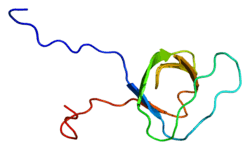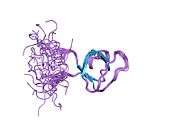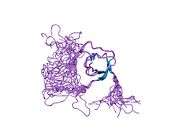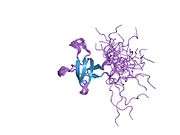Intersectin 2
Intersectin-2 is a protein that in humans is encoded by the ITSN2 gene.[3][4][5]
This gene encodes a cytoplasmic protein which contains SH3 domains. This protein is a member of a family of proteins involved in clathrin-mediated endocytosis. Intersectin 2 is thought to regulate the formation of clathrin-coated vesicles and also may function in the induction of T cell antigen receptor (TCR) endocytosis. Alternatively spliced transcript variants have been found for this gene that encode three distinct isoforms. Additional variants have been found but their full length nature has not been determined.[5]
Interactions
ITSN2 has been shown to interact with Wiskott-Aldrich syndrome protein.[4]
References
Further reading
- Andersson B, Wentland MA, Ricafrente JY, et al. (1996). "A "double adaptor" method for improved shotgun library construction.". Anal. Biochem. 236 (1): 107–13. doi:10.1006/abio.1996.0138. PMID 8619474.
- Yu W, Andersson B, Worley KC, et al. (1997). "Large-scale concatenation cDNA sequencing.". Genome Res. 7 (4): 353–8. doi:10.1101/gr.7.4.353. PMC 139146
 . PMID 9110174.
. PMID 9110174.
- Sparks AB, Hoffman NG, McConnell SJ, et al. (1998). "Cloning of ligand targets: systematic isolation of SH3 domain-containing proteins.". Nat. Biotechnol. 14 (6): 741–4. doi:10.1038/nbt0696-741. PMID 9630982.
- Nagase T, Ishikawa K, Kikuno R, et al. (2000). "Prediction of the coding sequences of unidentified human genes. XV. The complete sequences of 100 new cDNA clones from brain which code for large proteins in vitro.". DNA Res. 6 (5): 337–45. doi:10.1093/dnares/6.5.337. PMID 10574462.
- Pucharcos C, Casas C, Nadal M, et al. (2001). "The human intersectin genes and their spliced variants are differentially expressed.". Biochim. Biophys. Acta. 1521 (1–3): 1–11. doi:10.1016/s0167-4781(01)00276-7. PMID 11690630.
- Nakayama M, Kikuno R, Ohara O (2003). "Protein-protein interactions between large proteins: two-hybrid screening using a functionally classified library composed of long cDNAs.". Genome Res. 12 (11): 1773–84. doi:10.1101/gr.406902. PMC 187542
 . PMID 12421765.
. PMID 12421765.
- Strausberg RL, Feingold EA, Grouse LH, et al. (2003). "Generation and initial analysis of more than 15,000 full-length human and mouse cDNA sequences.". Proc. Natl. Acad. Sci. U.S.A. 99 (26): 16899–903. doi:10.1073/pnas.242603899. PMC 139241
 . PMID 12477932.
. PMID 12477932.
- Chini CC, Chen J (2003). "Human claspin is required for replication checkpoint control.". J. Biol. Chem. 278 (32): 30057–62. doi:10.1074/jbc.M301136200. PMID 12766152.
- Ota T, Suzuki Y, Nishikawa T, et al. (2004). "Complete sequencing and characterization of 21,243 full-length human cDNAs.". Nat. Genet. 36 (1): 40–5. doi:10.1038/ng1285. PMID 14702039.
- Brill LM, Salomon AR, Ficarro SB, et al. (2004). "Robust phosphoproteomic profiling of tyrosine phosphorylation sites from human T cells using immobilized metal affinity chromatography and tandem mass spectrometry.". Anal. Chem. 76 (10): 2763–72. doi:10.1021/ac035352d. PMID 15144186.
- Lehner B, Sanderson CM (2004). "A protein interaction framework for human mRNA degradation.". Genome Res. 14 (7): 1315–23. doi:10.1101/gr.2122004. PMC 442147
 . PMID 15231747.
. PMID 15231747.
- Rush J, Moritz A, Lee KA, et al. (2005). "Immunoaffinity profiling of tyrosine phosphorylation in cancer cells.". Nat. Biotechnol. 23 (1): 94–101. doi:10.1038/nbt1046. PMID 15592455.
- Zhang Y, Wolf-Yadlin A, Ross PL, et al. (2005). "Time-resolved mass spectrometry of tyrosine phosphorylation sites in the epidermal growth factor receptor signaling network reveals dynamic modules.". Mol. Cell Proteomics. 4 (9): 1240–50. doi:10.1074/mcp.M500089-MCP200. PMID 15951569.
- Nishimura T, Yamaguchi T, Tokunaga A, et al. (2006). "Role of numb in dendritic spine development with a Cdc42 GEF intersectin and EphB2.". Mol. Biol. Cell. 17 (3): 1273–85. doi:10.1091/mbc.E05-07-0700. PMC 1382316
 . PMID 16394100.
. PMID 16394100.
- Seifert M, Ampofo C, Mehraein Y, et al. (2007). "Expression analysis of human intersectin 2 gene (ITSN2) minor splice variants showing differential expression in normal human brain.". Oncol. Rep. 17 (5): 1207–11. doi:10.3892/or.17.5.1207. PMID 17390067.
- Lim CS, Seet BT, Ingham RJ, et al. (2007). "The K15 protein of Kaposi's sarcoma-associated herpesvirus recruits the endocytic regulator intersectin 2 through a selective SH3 domain interaction.". Biochemistry. 46 (35): 9874–85. doi:10.1021/bi700357s. PMID 17696407.
PDB gallery |
|---|
|
| 1j3t: Solution structure of the second SH3 domain of human intersectin 2 (KIAA1256) |
| 1udl: The solution structure of the fifth SH3 domain of intersectin 2 (KIAA1256) |
| 1ue9: Solution structure of the fourth SH3 domain of human intersectin 2 (KIAA1256) |
| 1uff: Solution structure of the first SH3 domain of human intersectin2 (KIAA1256) |
| 1uhf: Solution Structure of the third SH3 domain of human intersectin 2(KIAA1256) |
|
|


 . PMID 11748279.
. PMID 11748279. . PMID 9110174.
. PMID 9110174. . PMID 12421765.
. PMID 12421765. . PMID 12477932.
. PMID 12477932. . PMID 15231747.
. PMID 15231747. . PMID 16394100.
. PMID 16394100.



